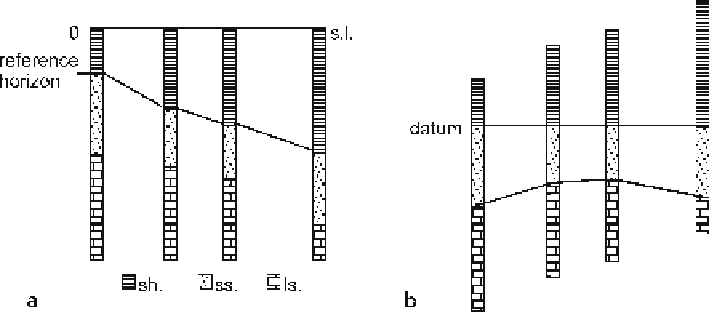Geology Reference
In-Depth Information
Fig. 11.41.
Flattening to a datum by vertical simple shear.
a
Deformed-state cross section based on
lithological logs. The zero elevation is sea level (
s.l.
);
sh:
shale;
ss:
sandstone;
ls:
limestone.
b
Cross sec-
tion flattened to a datum at the top of the sandstone shows a paleo-anticline at the top of the limestone
reference horizon is horizontal (Fig. 11.41b). The operations required to restore the
cross section may be easily performed by an overlay method. Draw a set of equally
spaced vertical lines on the cross section to represent the positions of columns to be
restored. The spacing of the vertical lines controls the level of detail in the horizontal
direction that will be obtained in the restoration. Draw a horizontal line on a transpar-
ent overlay to represent the restored datum. Mark the horizontal position along the
datum line of each column to be restored. Shift the overlay to bring each column to the
restored datum and mark on the overlay the position of each stratigraphic unit. Com-
plete the restoration by connecting the stratigraphic horizons to form a continuous
cross section.
If the cross section includes faults, their displacements can be removed in the res-
toration. In the simple shear model, fault displacement parallel to the regional is con-
stant and equal to the hangingwall block displacement,
D
. The steps in the restoration
are given below (refer to Fig. 11.42 for the geometry).
1. Define the regional.
2. Find the block displacement by projecting a vertical line from the hangingwall cutoff
of the reference bed to the regional. The block displacement is the distance
D
par-
allel to regional from the footwall cutoff of the marker bed.
3. Construct a series of vertical working lines, spaced
D
apart, starting at the fault.
4. To restore the hangingwall, each vertical segment along a working line in the
hangingwall is moved up the fault until the horizontal component of displacement
is equal to
D
. The base of each segment remains in contact with the fault and the top
marks the position of the restored reference bed. Record the position of each marker
horizon along the working line.
5. Repeat step 4 for as many vertical hangingwall segments as necessary to produce a
smooth restoration of the hangingwall beds.

